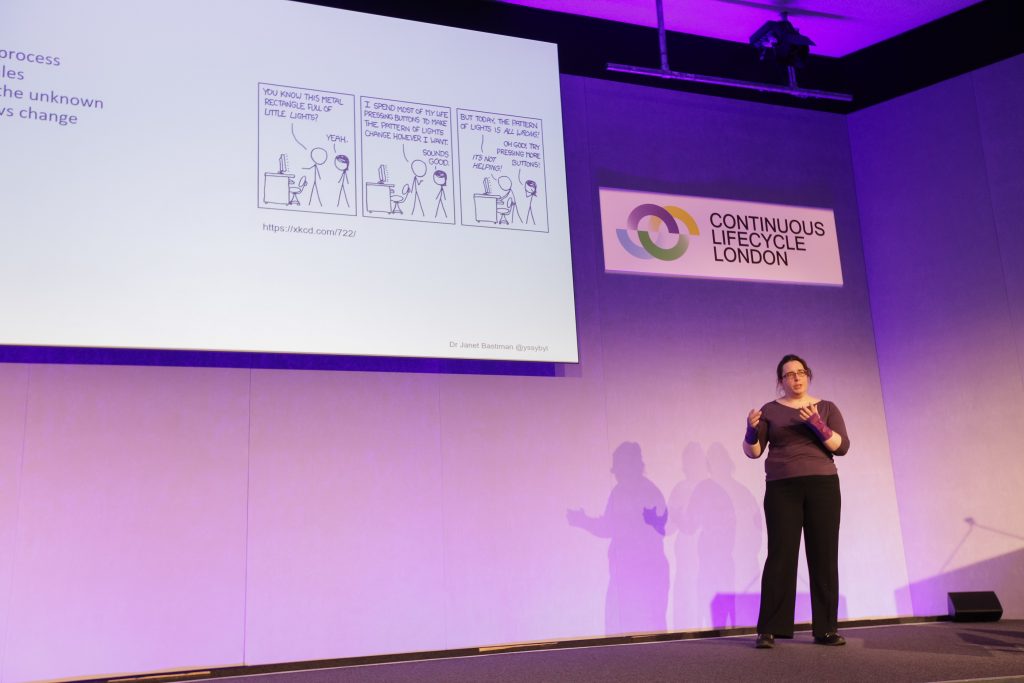
One of the things I’ve been doing more this year is speaking more at conferences and meetups. I always take the time to speak to the audience afterwards to see if there were aspects they didn’t get or enjoy, so I can hone the presentation for the next time1. Even when under embargo of product details, there’s usually lots of things that you can talk about that the wider community will find interesting and I have been encouraging people to break their presentation fear by talking at meetups.
Following on from my “Being a Panellist” post, I’ve been asked a lot how I go about writing a presentation and what I do to prepare, so I’ve gathered my thoughts here. This isn’t the only way, but it is what works for me!
Firstly, things to ask.
- Who are the audience and how many people will be there? For a technical talk it’s good to know whether you’re speaking to developers, managers or execs, or a potentially mixed group.
- How long do they want you to speak for and are there other speakers – if so what are their topics? You don’t want to be the third person speaking on the same topic in an hour, or if you do, you need to have a different angle.
- Will it be recorded (video or audio)? Some people can freeze up if they get an unexpected camera in their face. You should assume that people will be taking pictures on their phones and live tweeting anything interesting so put your social media handles/LinkedIn profile on your slides so they can @ you appropriately.
- Will you be using your own laptop or will you need to put your slides onto another machine? This can cause all sorts of compatibility problems and is the main reason I don’t use any fancy transitions or animations. I also have my own clicker as I like to pace a lot 😀 2.
Then, what are you actually going to talk about – what is the focus?
The key thing to remember here is that everyone in the room is as intelligent as you are, but do not know what you know. While their experience and/or views may overlap in places, nobody else will have your exact experience and viewpoint and so everyone should listen. This was the key piece of advice I was given when writing my PhD thesis – it should be accessible to any person educated at least to degree level, whether they are studying your subject or not. The same is true of any presentation – it needs to be accessible without being too basic. You’ll find the right level based on your audience. Introduce the terms you need and build upon them. This is particularly true in my field – practically every talk I go to has a variation on what they mean by “AI”! Even if your audience uses different meaning for the same terms, you will avoid confusion3.
Then, based on how long I’ll be speaking for and my main topic, I can work out how many different ideas I want to introduce and in how much detail. While your talk should focus on one key message, you can break this down into different ideas. I like to think of these as chapters in my story. They can look at things from a different angle but all help to build towards a conclusion – the key message you want your audience to hear. Just like having chapters in a book that are too short is a bit odd, too many ideas in too short a time and you’ll leave your audience confused. For a ten minute talk don’t have more than 3 different ideas. But for a longer talk, each individual idea could be over ten minutes, allowing you to go into more detail.
Once I’ve defined my key message and ideas I want to get across based on the timings I think about what I’m going to say. Some people start with slides here, but I start with the story. I’ll sit down with my idea bullet points and write an essay. I talk slowly and ad lib a lot so for each 10 minutes I have, I write about 1000 words. For a 10 minute talk with 3 ideas, this is around 300 words per idea, not a lot. For some of my longer talks, I might spend up to 1000 words on a single idea. I don’t write these long essays to read out verbatim, but to organise my thoughts. This makes sure I have a compelling story, I can separate opinion from referenced statements, and gathers my research all in one place4.
Only when I’m happy with my story do I put together the slides. Sometimes this is literally minutes before I start talking as I want to refer to an earlier talk or a recent paper. Usually this is in the day or two before the talk, although some conferences want a copy weeks in advance, which breaks my system :). Because I’ve reviewed my story several times by this point, the flow and facts are clear in my head. Putting together the pertinent points on a slide helps cement these ideas. Quite often, the slides I present have very little information on them. People will read the slide as soon as it is projected. I don’t want to be talking while they are still reading – I want them to be listening to me. So I deliberately design my slides with some short quotes, or an image that I then explain. Nobody enjoys presentations where the speaker reads what’s on the screen – your slides should capture the imagination and then you hold your audience’s attention.

I don’t actually practise my talks through that much. Maybe I should. Please do if you want to as I’m not saying you shouldn’t. I don’t know why I don’t. I get uncomfortable rehearsing and it makes my presentations stilted because I’ve already given it several times and even I’m bored of it by that stage! I do however know my material inside out so it’s not an issue for me to stand up and talk for ten minutes to an hour on the topics I love. Do what works for you.
Other people I’ve worked with have very different styles. One guy I know is very visual and he will use 150 slides for a 15 minute presentation and rehearse the presentation at least 10 times. This is just as acceptable as my one slide per 5 minute approach.
Images for slides can be an issue and it’s the part that takes up most of my time. If I’m talking about latest research then there’s usually always good diagrams to use (as long as they are correctly referenced). For more abstract talks, or where you just need a little visual interest, it can be much harder. Quite often I find something that’s perfect, only to be unable to check if it can be used or to credit the original author as it has been posted so many times uncredited. If you want to stay safe, use your own images, or ones with rights purchased. If the image was created by anyone else, then make sure you reference them. It’s as simple as that.
Don’t change your style of speaking. Present how you naturally talk. If you are passionate about the subject then you will be engaging, it’s that simple. Don’t force jokes into your talk if you wouldn’t normally use them. In a talk recently I used a pun about not wanting to open a can of worms with C. Elegans research5, a reference to gaming platform twitch and the source of unbiased news Philip DeFranco. Not a single person in the room got any of them. But it doesn’t matter. This is how I talk and explain things, so I just moved on. Other aspects they got that maybe a different audience would not. I did a very similar talk a few weeks later and a different audience got all of it.
Give your audience something to think about and they will always enjoy your talk.
I always let people know if I am going to post my talk online afterwards. As my slides aren’t very self explanatory, I always add in wordy slides with the things I was talking about. If I can remember all the ad libs I made then I’ll write these in, otherwise I take most of it from my notes, including anything that I forgot and any updated references.
If you’re nervous about speaking then try a smaller meetup first. These are usually very welcoming groups where they will really help first time speakers.
Most of all, there will be people out there who don’t know something that you know – don’t be afraid of standing up and speaking about it.
- Or even just to augment the notes before putting it on Slideshare ↩
- Although I forgot this in my most recent talk! ↩
- I spent an afternoon in a meeting with a technical sales person who kept dropping SQL and LAMP into the conversation and it seemed very out of context as he wasn’t talking about databases or open source webservers 😀 ↩
- This also helps with annotating the slides after the event! ↩
- I’m not going to explain this one 🙂 ↩
Hi Janet,
I just followed you on Twitter but I don’t think you can DM unless you follow me back. I have just signed up for MST210 and although the course website doesn’t open until September I wanted to go through some recommended textbook etc before the course starts. Could you send me some suggestions? Thanks in advance
Hi Chris, thanks for reading – I’ll pop you a note via email.